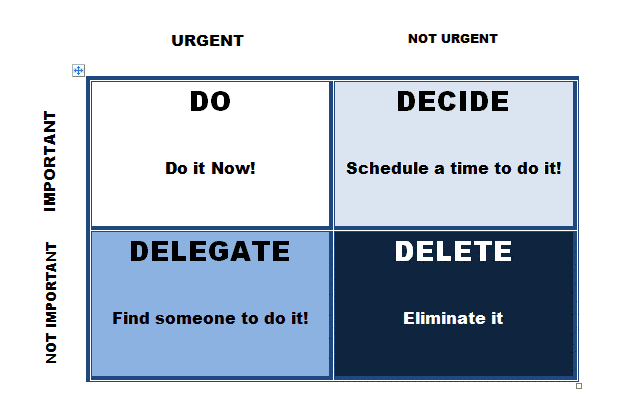How to Use the Prioritization Matrix When Every Task is #1
It takes being productive to get things done correctly and on time. So how do you know which tasks are essential and which can wait? The answer is in the Eisenhower Matrix.
The matrix took its name after Dwight David Eisenhower. Eisenhower was a general in the US army and the 34th President of the United States from 1953 to 1961. As a five-star general and a Supreme Commander in the US Army, he drafted the strategy for an Allied invasion of Europe.
Eisenhower had to make tough decisions every time about which tasks to prioritize out of many he needed to focus on daily. So, he came up with the famous Eisenhower Matrix, or the Prioritization Matrix.
What is the Eisenhower Matrix?
The Eisenhower Matrix is a technique of rating your tasks based on urgency. It helps you know the critical activities and those tasks that you should bypass. Eisenhower famously said of the Matrix:
“Most tasks that are urgent are not important, and most tasks that are important are not urgent.”
This quote became the maxim for Eisenhower in managing his time. Now let’s get down to the details of the Matrix. There are four quadrants, which include the tasks you need to do at every point in time.


The quadrants are:
- Do
- Decide
- Delegate
- Eliminate
Do
Do is the first quadrant in the Prioritization Matrix, and it incorporates important activities. That is, those tasks you need to carry out urgently — crises, deadlines, and issues that need your urgent attention and are highly relevant to your life mission. So how do you know which task falls into this quadrant?
It’s simple!
Start by analyzing your priorities, and then establish if it falls within the ‘do it now’ criteria. If the task is achievable within a day, or within 24 to 48 hours, it’s urgent. Another approach you can adopt in prioritizing tasks in this category is to adopt the “eat the frog” principle by Mark Twain. This principle recommends that you do the most urgent activities as soon as you wake up.
Here’s a practical example.
Let’s say you need to draft a content strategy and submit a report to your manager. It’s Saturday, and the deadline for submission is Monday. Can we say the activity is urgent? Definitely!
Decide
The second quadrant of the prioritization matrix is Decide. The Eisenhower Matrix classifies tasks in this category as important but not that urgent. They are long-term objectives and tasks with no immediate deadline. Those tasks could include meditation, journaling, studying, family time, and exercising.
You can plan out activities in this quadrant for some other period. For instance, you should exercise for good health, but you can allocate time to do it.
Schedule these activities in such a way that they don’t transfer to the “Do” or “Urgent” quadrant. Ensure you have sufficient time and dedicate that time to carry them out.
Delegate
The third quadrant of the prioritization matrix is Delegate. These tasks are not important to you but quite urgent for others. This is where teamwork comes into play.
You can technically perform tasks in this category, but it makes sense to delegate them. Delegating tasks will ensure you have more time to pursue activities in your first two quadrants.
You should also monitor the tasks you have delegated. You can use email, Skype, or telephone to get feedback. It will only amount to a sheer waste of time if you don’t have a tracking system for delegated tasks.
Delete
The last quadrant highlights your productivity killers. They are tasks that are not important to your goals. The only way to boost your productivity is to delete them.
Some examples are constantly checking your phone, watching movies, or playing video games.
They could also be bad habits that you need to identify and delete from your daily and weekly schedule.
Successful people have learned how to prioritize and stick to what’s important. They have learned to find a better person for a task or eliminate less significant tasks.
Let’s consider two inspiring personalities that have designed their prioritization system.
Warren Buffet developed a two-list prioritization model to determine which task deserves his best attention. The bottom line is bypassing things that are important and useful but not top of the priorities. Mark Ford, a business advisor, marketer, self-made millionaire, and author devised his strategy:
“Start work on the most crucial priority, take a break, work on the second most important task, take a break, then sort out the less important activities and any tasks he received from other individuals by afternoon.” [2]
Mark’s strategy may sound reasonable and easy, but some individuals have also devised their prioritization strategy, just like Mark and Warren.
The lesson is simple!
Prioritize, focus, repeat.


How to Use The Prioritization Matrix When Every Task Is #1
Using the Prioritization Matrix can be tricky if you’re new at it, but by following a few simple steps, you can learn to utilize it in the best way possible.
1. List and Rank Your Priorities
Highlight all the tasks you need to carry out in a day. Don’t mind the order or number.
Then, classify them based on urgency and importance.
Identify any activity that requires prompt action. I’m referring to a task that if you don’t complete that day, it could produce a grave consequence. For instance, if you don’t submit your content strategy, other content writers cannot work. It means you need to check for high-priority dependencies.
2. Define the Value
The next step is to examine the importance and assess which of them impacts your business or organization the most. As a rule of thumb, you can check which tasks possess higher priority over others. For instance, you need to attend to client’s requirements before you take care of any internal work.
You can also estimate value by examining how the task impacts the people and customers in the organization. In a nutshell, the more impact a task has on people or the organization, the higher the priority.
3. Take out the Most Challenging Task
Procrastination is not a symptom of laziness, but avoidance is. The truth is that you will typically avoid tasks you don’t want to do. The former CEO of Goldman Sachs, Lloyd Blankfein, once said he would take out the most dreaded task first thing when he got to the office.
It’s simple!
Take out any task that you dread first! Brian Tracy called these tasks the frogs you need to eat. That will remove the nagging dread, which mounts pressure on you when you postpone necessary tasks.
4. Know What’s Important to You
As long as you are in this cosmos, you will always encounter different choices that may be contradictory to your goals. For instance, a fantastic promotion that requires excessive travel will isolate you from important relationships. If you are not priority-conscious, you may accept it, even though your family is your priority.
Therefore, it makes sense to identify what is important to you and to prepare yourself not to compromise those important things for immediate pleasure or gain.
Yogi Berra captioned it this way:
“If you do not know your destination, you might end up somewhere else.”
5. Establish Regular “No Work” Time
YouTube CEO Susan Wojcicki established a rule not to check her emails between 6 p.m. and 9 p.m. According to a CNN Business report, she was the first woman to request maternity leave when Google just got started. She prioritizes dinner time with her family despite being the CEO of YouTube
Is it possible to cut out time for our relationships and interests outside of work? Of course!
That’s why you need to set out your “no work” time. This approach will enable you to renew your energy levels for the next task. Also, you will be in the best position to introspect as you are not in your usual work zone.
6. Know When to Stop
You can achieve everything on your list sometimes. After you have prioritized your workload and assessed your estimates, remove the remaining tasks from your priority list and focus on your most urgent and important tasks.


